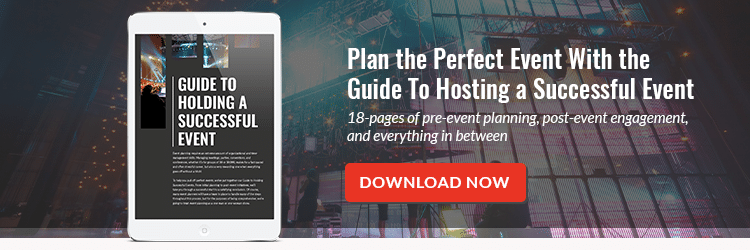Welcome to part two of our social media series! It’s hard to believe, but social media is still just a kid. Though its beginnings are rooted in the late 90s, it wasn’t until the advent of MySpace in 2003 that anyone really took notice. While that social site has seen better days, new sites have stepped up and given rise to a social media phenomenon, with Americans now spending more than 215 weekly minutes on social media via smartphone and an additional 110 minutes on laptops, desktops, and tablets. In part one of this series, we covered Facebook, Twitter, and Linkedin, and discussed how you can use them to promote your next event. Now, let’s take a look at three more social media giants: Instagram, YouTube, and Snapchat.

- Showing off your venue and attendees. Because Instagram is a visual space, highlight the location in advance. This may get Instagrammers excited about it and lead to sharing, increasing your visibility within the community. If you’re unsure of which venue you’re going to use, you might consider posting shots of each potential location and asking followers to vote on their favorite. This makes things interactive and helps you by narrowing down your choices. If your event will feature a well-known professional speaker or celebrity, you’ll always want to post a quick clip of a previous engagement they’ve spoken or performed at.
- Posting when the timing is right. The latest algorithms show that the best time to post and get viewed on Instagram is 5 pm EST (catching those winding down from work) and 2 am EST (catching insomniacs and those just getting home from a late night out!)
- Using Instagram Stories. Instagram Stories lets you put as many photos and videos as you want into a slideshow format that plays in sequence. Stories are live for just 24 hours, which creates a sense of urgency with Instagrammers, making them more likely to view them. Instagram Stories also post to your followers’ timelines in the sweet spot, right at the top of their page. Don’t forget to add some face filters, text, or stickers to your photos if you’re hosting a playful event.
If your event spans multiple days, don’t forget to post fun photos frequently during the event. This can tap into people’s FOMO (Fear Of Missing Out) and may have them signing up or buying tickets for the next day.
YouTube

- Customize your channel with imagery, colors, links, and information. Customizing player thumbnails can also encourage plays, click-throughs, and shares.
- Create a descriptive video title to encourage clicks. In your description, highlight topics, takeaways, sponsors, and speakers if it’s a corporate event, or featured guests and celebrities if it’s a social affair. This text will help the video get recognized by Google and YouTube, which can’t view the video—yet. You should also include a link to your event website.
- Include tags to come up in searches. YouTube has 15 to choose from that can help your video be discovered. You can learn how tags work in this YouTube video.
Finally, don’t forget to interact with fellow YouTubers. When they leave a comment on your video, respond as quickly as possible. Personalizing the response is great if you can, and if it’s negative, respond positively or simply ignore it so there are no regrets later.
Snapchat

Ready to Get Social?
These three social media giants are a great way to get the word out about your next event. Used individually or in conjunction with one another, they can have a tremendous impact on turnout and the talk around town. Be sure to check out part one in our series to learn more about Facebook, Twitter, and Linkedin, and then get out there and be that social butterfly! Of course, you don’t want to draw hundreds or thousands of people to an event with subpar audio and visual, right? One Way Event Productions can make your next event look and sound great. To learn more, contact us today.


